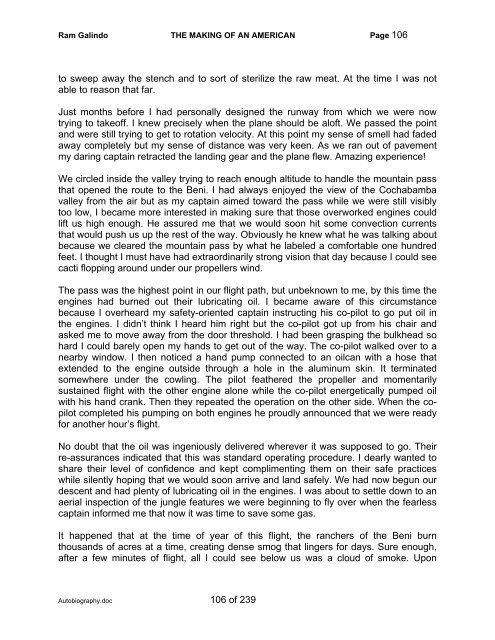Autobiography - The Galindo Group
Autobiography - The Galindo Group
Autobiography - The Galindo Group
You also want an ePaper? Increase the reach of your titles
YUMPU automatically turns print PDFs into web optimized ePapers that Google loves.
Ram <strong>Galindo</strong> THE MAKING OF AN AMERICAN Page 106<br />
to sweep away the stench and to sort of sterilize the raw meat. At the time I was not<br />
able to reason that far.<br />
Just months before I had personally designed the runway from which we were now<br />
trying to takeoff. I knew precisely when the plane should be aloft. We passed the point<br />
and were still trying to get to rotation velocity. At this point my sense of smell had faded<br />
away completely but my sense of distance was very keen. As we ran out of pavement<br />
my daring captain retracted the landing gear and the plane flew. Amazing experience!<br />
We circled inside the valley trying to reach enough altitude to handle the mountain pass<br />
that opened the route to the Beni. I had always enjoyed the view of the Cochabamba<br />
valley from the air but as my captain aimed toward the pass while we were still visibly<br />
too low, I became more interested in making sure that those overworked engines could<br />
lift us high enough. He assured me that we would soon hit some convection currents<br />
that would push us up the rest of the way. Obviously he knew what he was talking about<br />
because we cleared the mountain pass by what he labeled a comfortable one hundred<br />
feet. I thought I must have had extraordinarily strong vision that day because I could see<br />
cacti flopping around under our propellers wind.<br />
<strong>The</strong> pass was the highest point in our flight path, but unbeknown to me, by this time the<br />
engines had burned out their lubricating oil. I became aware of this circumstance<br />
because I overheard my safety-oriented captain instructing his co-pilot to go put oil in<br />
the engines. I didn’t think I heard him right but the co-pilot got up from his chair and<br />
asked me to move away from the door threshold. I had been grasping the bulkhead so<br />
hard I could barely open my hands to get out of the way. <strong>The</strong> co-pilot walked over to a<br />
nearby window. I then noticed a hand pump connected to an oilcan with a hose that<br />
extended to the engine outside through a hole in the aluminum skin. It terminated<br />
somewhere under the cowling. <strong>The</strong> pilot feathered the propeller and momentarily<br />
sustained flight with the other engine alone while the co-pilot energetically pumped oil<br />
with his hand crank. <strong>The</strong>n they repeated the operation on the other side. When the copilot<br />
completed his pumping on both engines he proudly announced that we were ready<br />
for another hour’s flight.<br />
No doubt that the oil was ingeniously delivered wherever it was supposed to go. <strong>The</strong>ir<br />
re-assurances indicated that this was standard operating procedure. I dearly wanted to<br />
share their level of confidence and kept complimenting them on their safe practices<br />
while silently hoping that we would soon arrive and land safely. We had now begun our<br />
descent and had plenty of lubricating oil in the engines. I was about to settle down to an<br />
aerial inspection of the jungle features we were beginning to fly over when the fearless<br />
captain informed me that now it was time to save some gas.<br />
It happened that at the time of year of this flight, the ranchers of the Beni burn<br />
thousands of acres at a time, creating dense smog that lingers for days. Sure enough,<br />
after a few minutes of flight, all I could see below us was a cloud of smoke. Upon<br />
<strong>Autobiography</strong>.doc 106 of 239


